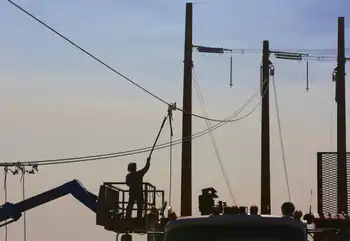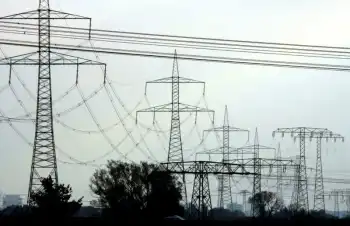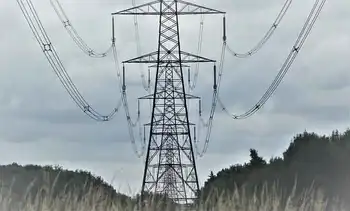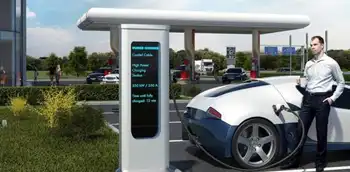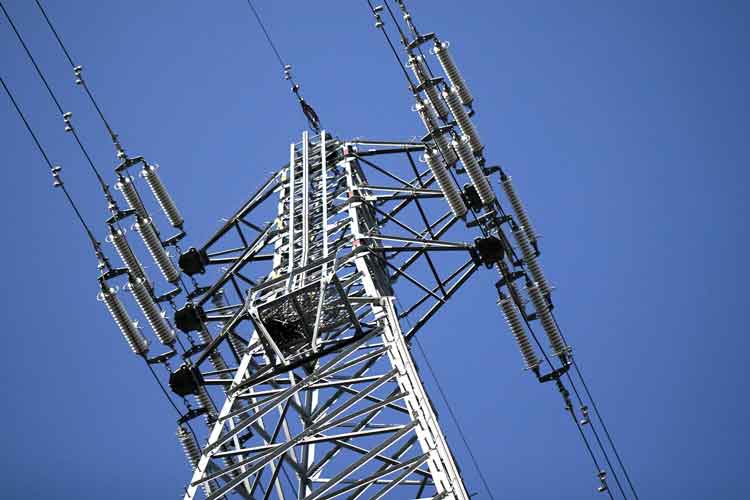The electronic drain of household products
By Chicago Tribune
Protective Relay Training - Basic
Our customized live online or in‑person group training can be delivered to your staff at your location.

- Live Online
- 12 hours Instructor-led
- Group Training Available
Clean-coal technology. Alternative energy sources. Plug-in hybrid cars that get up to 150 miles a gallon.
But what about the ugly little technology secrets Americans like to keep under the rug? The fact that the American home is teched-up like never before, with shiny tech toys that suck electricity in huge amounts, when one considers the impact in aggregate, as a nation.
Today's average American home now has three televisions, two DVD players or recorders, 1.16 digital cameras, one desktop computer and two cell phones, among other consumer electronics products (the average American household has 24 of such things), according to the Consumer Electronics Association.
The fallout: Consumer electronics is one of the fastest-growing categories of electricity use in the home — up from 5 percent in 1980 to nearly 15 percent of a home's total electricity consumption today. By 2015, it's estimated to be closer to 20 percent for many homes.
All by itself, the TV (swollen to a size of 40 inches or larger for the "main" TV in the house) represented a stunning 8 percent of residential electricity consumption in the U.S. in 2007, nearly doubling in just three years.
And: America's video game console habit consumes as much electricity on an annual basis as the entire city of San Diego.
"I think for a long time most of us thought about the major energy consumers in our home as being our appliances and our heating and cooling and hot water heating. And we never thought a lot about our tech products," says Katharine Kaplan, EPA team lead, Energy Star product development.
But Americans didn't have three TVs per household. "We didn't watch them as many hours, didn't use them for gaming, didn't use them to show our photographs, didn't have TiVo, didn't have sophisticated content options that make watching so desirable," Kaplan goes on. "And we certainly didn't have all these miscellaneous products that we plug in."
The good news: A little awareness goes a long way.
There are simple adjustments that consumers can make in the use of their technology equipment and toys to make them notably more efficient.
Consider: Reducing the brightness of a TV set can cut its energy use by as much as 25 percent. Getting rid of the screen saver on a computer can save $50 to $100 in electricity costs over a year.
And when it comes to new tech purchases, it's good to be aware that there are now greener options. Programs and organizations such as Energy Star and the Natural Resources Defense Council have done considerable work to encourage manufacturers to deliver more energy-conscious products.
Some highlights from the International Consumer Electronics Show held in January in Las Vegas include:
•LG Electronics showed a line of HDTVs that use light-emitting diodes (less power-hungry than fluorescent tubes) to light the TV screen from behind. Other companies announced they are exploring "LED backlighting" as well.
• Sony announced that in addition to its line of Bravia LCD HDTVs that will be in stores this spring and meet the new, more stringent specifications from Energy Star, it's coming out with lighting technology that reduces energy use by almost 40 percent, compared with other Sony LCD HDTVs. Sony says these new TVs also use 0 watts in standby mode, after being left unattended for a while, and have a motion sensor that turns off the TV when users forget.
And then there were a slew of relatively inexpensive smart power strips or related devices that address vampire power. That's the term for electricity consumed when electronics are turned off and are, for all intents and purposes, off. But if they're plugged in, they're still consuming some electricity.
The Belkin Conserve Power Strip is an eight-plug power strip/surge protector that accommodates all kinds of equipment with varying needs of staying connected. Six of those eight outlets can be powered off completely. The remaining two are always on (and are meant for electronics that need to stay "on" 24/7 such as DVR boxes and networking equipment). The Conserve comes with a wireless remote that quickly turns "on" or "off" the six configurable plugs.
Now, have a look and read at the usual techno suspects around the house and what owners can do to be smarter users.
Televisions: In general, the amount of power a TV uses increases with screen size. A 52-inch, high-definition TV can use as much energy annually as a new refrigerator. And that's likely to be two times more energy than a consumer's old, smaller TV.
LCD or plasma? "The typical 42-inch plasma TV uses approximately 100 more watts than a similar sized LCD," according to Noah Horowitz, senior scientist at the Natural Resources Defense Council. That amounts to at least $200 more in electricity, over the life of the product.
To do:
• Turn down the brightness of your existing TV and cut your energy use as much as 25 percent depending on the TV. Most TVs (traditionally) ship at an overly bright level, meant for display in retail stores. The "standard" or "home" mode is recommended. Go to the TV setup menu and make the changes.
• When shopping for a new set, look for TVs bearing the ENERGY STAR mark. They are up to 30 percent more energy efficient than other models, thanks to a new specification set by ENERGY STAR that went into effect in November. To find a list of qualified TVs, go to www.energystar.gov/televisions.
• Also look for a TV with automatic brightness control. It's a sensor that automatically adjusts the picture level according to the light levels in the room.
Green piece: NRDC and the EPA estimate that the move to more energy-efficient TVs could cut $1 billion from the nation's annual electric bill, reducing greenhouse gas emissionsby the equivalent of taking some 1 million cars off the road.
Set top boxes (Cable box, satellite box, boxes with DVR function, TiVo):
They're big-time power suckers. Unlike the TV (which goes into a standby or low-power mode when it's turned "off") these boxes run at near full power 24/7. Some of the fuller-featured ones (those with TiVo-like capability) can consume more than 250 kWh a year. That's roughly equal to half the annual energy use of a new refrigerator.
To do: Ask your service provider for one of the new ENERGY STAR-qualified set top boxes, which became available January 1. Or at least ask your provider to investigate getting them. Although it's a first-step by ENERGY STAR with more stringent guidelines to come in the next few years, set top boxes that meet this first spec are at least 30 percent more energy efficient than other models — and largely because portions of the device power-down when the box is not in use.
Green pieces: According to the EPA, if all set top boxes sold in the U.S. met the new ENERGY STAR spec, some $2 billion could be cut from the nation's annual electric bill, reducing greenhouse gas emissions by the equivalent of taking 21/2 million vehicles off the road.
NRDC is working with designers of set top boxes to bring to market a new generation of super-efficient boxes that use 50 percent to 75 percent less energy each year than current models. According to NRDC, the benefits could be massive. It could eliminate the need for up to five large power plants.
Power strip/surge protector. One of the most useful tools for eco-conscious consumers with lots of techno toys. They make it easy to completely "power off" electronics that go into a standby or low-power mode when you think you're turning them "off." U.S. households spend about $100 a year on such vampire power. Consumer electronics account for about $40 of those $100.
As a nation, those numbers get even more dramatic: It's estimated standby power accounts for more than 100 billion kWh of annual U.S. electricity consumption and $11 billion in annual energy costs.
In the home office: Computer, computer speakers, printer and scanner could be plugged into a single power strip/surge protector — which could be powered off at the end of the day (after first powering down each device). Modems for AT&T DSL (high-speed Internet) also could be plugged into the power strip and powered off. Cable connections to the Internet (i.e. Comcast) should be plugged into a separate outlet and left "on" at all times, as Comcast updates during the night.
In the living room: TV, DVD player and surround-sound system are good candidates for a power strip/surge protector that could be powered off at the end of each day. Set top boxes are not. They need to be running 24/7 to receive updates, video downloads, etc. from the service provider.
External power supplies (Little black boxes to charge everything from cell phones and BlackBerrys to computer printers and digital cameras).
They may be small but they're not insignificant. The average American has five or more of them and they're often left plugged in 24/7 — and that's a big no-no, or at least it has been in the past. These boxes typically were very inefficient, as they converted a lot of incoming power into waste heat.
To do:
• Best case scenario: Unplug power supplies when they're not charging something up.
• And thank the state of California, which enacted a law that went into effect in 2007, setting a higher energy efficiency standard for these devices. That law inspired the same efficiency standard on a national level. New power supplies now must (among other things) use a mere 0.5 watts when left plugged into the wall with nothing charging on the other side.
Green pieces: Compared to the old power supplies sold five years ago, power supplies that meet the new standard will save more than 5 billion kWh a year in the U.S., preventing the release of about 3.8 million tons of greenhouse gas emissions, according to the NRDC. That's the equivalent of removing 600,000 cars from the road.
Video game consoles: More than 40 percent of all U.S. homes have at least one of these, according to a recent study by the Natural Resources Defense Council. Assuming half of these are left on all the time, our video game habit as a nation consumes an estimated 16 billion kWh a year in electricity. That's about equal to the annual electricity use of the city of San Diego.
Know: You're wasting $100 or more a year in electricity if you leave some of these consoles on 24/7. (Microsoft Xbox 360 and Sony PlayStation 3 are power hungry, consuming an average of more than 100 watts when "on.")
Interesting: Nintendo Wii doesn't come close to that consumption. It uses an average of just 16 watts in Active mode, costing less than $15 a year in electricity to operate if left on 24/7, according to the NRDC study. That's because Wii focuses on "novel, interactive game play rather than power hungry, high-end graphics," according to NRDC.
To do:
• Do save your game and power-down the system when you're done.
• Do enable the auto-shutdown, power-saving mode if you've got it. And yes, it's up to the gamer to enable this feature. Go to www.nrdc.org/energy/consoles /contents.asp for instructions.
Green pieces: According to NRDC, some 11 billion kWh of electricity could be saved each year in the U.S. (avoiding more than 7 million tons of carbon dioxide emissions each year and saving $1 billion a year from the nation's annual electric bill) if manufacturers would incorporate more user-friendly power management features into their game consoles.
Computers: The annual electricity usage of a computer that's used sloppily (left on and not power managed) can account for up to one-tenth of a car's carbon dioxide emissions.
Do's and Don't's:
• Don't disable the power management feature. Most of today's computers ship with it "enabled." It tells the monitor/computer when to go sleep (after a preset period of inactivity) and when to go into a deeper, power-saving mode, called standby. Change/check the settings by clicking on your Start button, then click Control panel, then Power options.
• Do plug your computer into a power strip/surge protector and power that off completely at the end of the day — after first powering down the computer. If you're worried about getting updates from Microsoft, download them yourself on Tuesday, Microsoft's send day. If you have Windows XP, it's an option in Internet Explorer under the Tools drop down menu. In Windows Vista, find Windows Update in the Start menu.
• Do wait till July to buy a new computer — if you're uber-green. That's when some of the industry's most energy-efficient computers hit the market, thanks to a new specification from ENERGY STAR. Desktops and notebooks that meet the new spec will use 30 percent less energy on average than most other computers on the market. A list of qualified products will be available July 1 at www.energy star.gov (select Office Equipment from the list of products and check the right sidebar for an Excel listing of qualified products).
• Do get rid of your screen saver. Unlike 10 years ago, the screen saver serves no useful purpose and does not extend the life of your monitor. Killing it could save you $50 to $100 on your electric bill over a year, depending on your equipment.
• Do consider a laptop. A new laptop could use up to four times less power than your old computer and LCD monitor.
Imaging equipment (Printers, copiers, scanners, fax machines, all-in-one-devices).
Wait until July if you're in the market for a new machine and want it to be shiny green. That's when a new energy-efficiency spec from ENERGY STAR goes into effect. Imaging equipment that meets the spec will be 14 percent more efficient than current qualified models.
Google search: Google uses 0.0006 kWh of energy to run two searches, resulting in about 0.4 grams of carbon dioxide emissions. And that's not the same (or anywhere near the same) as the 15 grams of carbon emissions from boiling (1 cup) of water for tea — which is what was (mis)reported in a Sunday London Times story earlier this year and cause of much Internet hubbub.
The better comparison: You would have to do 44,000 Google searches to equal the carbon emissions from burning just 1 gallon of gasoline.





